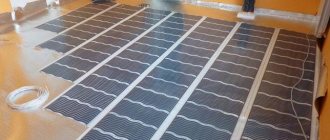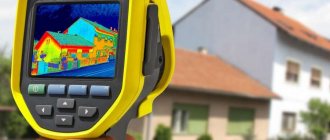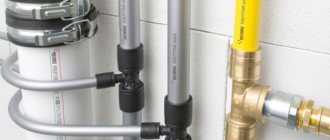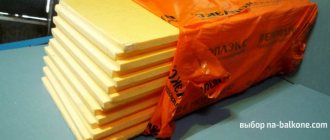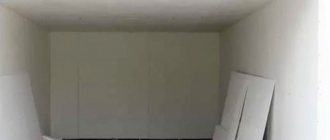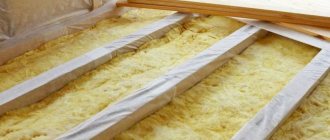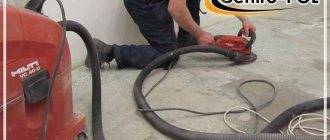The main advantages of foamed polyethylene
Despite the availability of thermal insulation materials on sale, the production of which began later than foamed polyethylene, insulation materials of the Isolon, Temaflex, Polyfom, and Penofol brands are in consumer demand because:
- the material has low thermal conductivity;
- the air-bubble structure of the insulating material prevents the spread of water vapor and the penetration of precipitation;
- the small thickness and high flexibility of the material facilitates installation, and the adhesive for polyethylene foam ensures its reliable fixation on the surface of building structures;
- if foamed self-adhesive polyethylene is used, installation of the heat-insulating layer is greatly simplified; it is carried out at the joint, over which aluminum tape is glued;
- if foil-foamed self-adhesive polyethylene is used, then after insulating the surface of the building structure with Penofol, it even acquires a certain beauty.
Welding film for a greenhouse
Using this method to create a single sheet of film for a greenhouse allows you to obtain a strong seam that will withstand loads. Provided that all actions are performed correctly. The creation of polyethylene as a material occurs under high pressure and high temperature. When reheating occurs using a welding machine to a melting state, the polyethylene shrinks slightly, but this is enough for the connection. Today there are two types of welding process:
- Welding film for greenhouse;
- Welding dense polyethylene. As a rule, thick material is used to make canisters and pipes.
To carry out heating and then gluing the film for the greenhouse with your own hands, use either two hot objects or specialized equipment. The device connects the two edges of the film using a hot wedge and two rollers. At the first stage, polyethylene is heated to the required temperature and then passed through rollers. If the temperature regime is selected correctly and the pressure between the rollers is selected correctly, then the result of gluing the film for the greenhouse will please you for a long time. Complete sealing of the seam will be achieved.
But to firmly connect the ends of polyethylene, it is not at all necessary to use an expensive device. With a little practice, a soldering iron or iron is perfect for gluing greenhouse film with your own hands.
When using an iron, it is necessary to make a paper gasket so as not to damage the base of the device.
If the soldering iron has a voltage regulator, the seam will be even better and the process will go better. In this case, you need to worry about the absence of burning on the tip of the device.
You can find an improved soldering iron for gluing film for a greenhouse, where a nozzle is attached to the tip, which is convenient to use when welding. In this case, the device can continue to be used for its intended purpose, and the polyethylene will be clean and there will be no solder or flux left on it.
If you use a thick film for gluing on a greenhouse, then it will be a little more difficult. Skill is required to obtain a satisfactory result. To glue greenhouse film, it is better to use a portable gas burner. You can also use a special construction hair dryer, which produces a stream of air with a temperature of 250 degrees.
What the process looks like:
- The surfaces to be glued are prepared. They are thoroughly cleaned of dirt and dried;
- The filler is prepared, which will be placed between the layers. It must be polyethylene;
- Start warming up. After the halves begin to melt, stop and let them “settle” slightly. However, do not delay the process;
- At this stage, the filler is introduced. It is fused into the seam from all sides. In this case, the layer of polyethylene filler should be equal to the layer of the seam itself;
- You can let the seam cool.
Adhesive mixtures for polyethylene foam
Experts, when recommending how to glue foamed polyethylene, suggest two-component mixtures based on methyl acrylate. For example, the well-known mixture from “Easy-Mix PE-PP”, which demonstrates high adhesion, allowing you to work even with polypropylene and simple polyethylene.
They have proven themselves well:
- “Quick-Bond” or “88-NP” (universal adhesive for this material;
- Akrol contact;
- spray "Neoprene 2136".
If you need to glue foamed polyethylene together, you can use:
- Cerezit CT83;
- Anserglob BCX 39;
- polymer cement mixture called “Aqualit SK-106 P”;
- "Master Super";
- "Polymin P-20";
- polyurethane aerosols “Stolit PC” or “Tytan Styro 753 O₂”.
The wall must be pre-cleaned, treated with an antiseptic, dried, and, if necessary, leveled. When fixing insulating material over large areas, we recommend using the adhesive mixture “Facade” or “Bolars” (packaged in 25 kg), pre-preparing the working solution in accordance with the manufacturer’s instructions.
Foamed polyethylene is often used for insulation and waterproofing, but for an effective and high-quality result, special glue must be used in tandem with polyethylene.
There are several types of glue:
— for exterior finishing and insulation, mounting adhesive for exterior work or liquid nails, which have a high degree of strength and are resistant to temperature changes and adverse weather conditions, are suitable;
- in a room with a high degree of humidity, in a bathhouse or bathroom, you will need MV-40 glue, which does not lose its adhesive qualities in a damp environment and has water-repellent properties;
— when insulating the inside of houses, apartments and other residential premises, you should choose non-toxic glue labeled “universal” or “express”.
There are also professional adhesive-based mixtures that have high performance and perform their functions perfectly. When dry, this mixture acquires a similar structure to the material, which gives solidity to the bonded surfaces. The correct choice of adhesive composition will help make the insulation of the room not only effective, but also durable.
Polyethylene and its properties
Polyethylene is a very common material with many excellent properties. It is used for insulation, for packaging, for protection from moisture, is an excellent electrical insulator, absorbs the most dangerous type of radiation - neutrons and is therefore used in protection against them, and is completely chemically resistant. This latter sometimes turns from an advantage into a disadvantage. How to glue polyethylene? Gluing is a chemical and a little electrical process, oddly enough. The molecules of the substances being glued are attracted to each other due to the difference in their electrical charges.
Polyethylene in hands
That is, there must be an adhesive in nature (and on the market) that adheres well to polyethylene, and when hardened, firmly holds the glued parts. So, the problem is that gluing polyethylene is very difficult. Its molecules are electrically very “balanced”, hence the extraordinary chemical resistance of the material. And a reluctance to stick to anything. However, the industry has found something to glue polyethylene with. True, not all of this is suitable for home, but some may come in handy. Here are the suitable methods, selected according to the resulting strength rating:
- Welding polyethylene
- Weicon Easy-Mix PE-PP Adhesive
- Epoxy glue plus oxidizing agent
Features of choosing adhesive for polypropylene and polyethylene
At home, vapor and waterproofing can be done with ordinary foamed polypropylene (polyethylene). Polypropylene insulation, although primitive, is highly effective, allowing you to save on the purchase of more expensive analogues.
Adhesive mixture for polyethylene
But you can’t get by with polyethylene alone, since its use requires polyethylene glue. In rarer cases, other adhesive-based mixtures are also suitable. They are needed for fixing polyethylene (the so-called polyethylene gluing) on the surface of thermal insulation or any other building structure.
And among the many different adhesive-based mixtures, it is necessary to choose the most optimal and effective one.
In order to glue polyethylene to thermal insulation, experts recommend using a specialized adhesive-based mixture “Easy-Mix PE-PP”.
Gluing polyethylene with acrylate glue
For gluing films or products made of polyethylene, acrylate adhesives are used, intended for joining materials with weak adhesion. It contains a filler made of glass microbeads, which does not allow the adhesive to slide off from the gluing site, so the connection is quite strong after the glue has completely hardened.
Before gluing, the surfaces to be joined must be thoroughly degreased and dried. The adhesive composition is supplied directly from the packaging. The optimal temperature value for polyethylene compound is +21. +23 °C. The glue released from the package must be used within 2-3 minutes, then it will lose its properties. After applying the composition, the surfaces to be glued are immediately joined and pressed. The maximum mechanical strength of the seam will be achieved within 4-5 hours. The new compound is aged at temperatures ranging from 15 to 70 degrees above zero.
What glue to use for gluing polyethylene - composition
The easiest way is to purchase structural adhesive in the store, which contains methyl acrylate. Its properties ensure rapid softening of polyethylene and its further gluing. The glue also contains inorganic and organic acids and xylene, chromic anhydride and various additives.
The advantage of using the mixture is that no additional processing of the material is required. However, polyethylene glue is quite toxic, so it is recommended to carry out work outdoors. The glue acquires its best properties at a temperature of +35C; it is not afraid of moisture, but is flammable. It is better to buy it in specialized stores so as not to run into a fake.
If there is a need to combine polyethylene with polyethylene, it is more convenient and easier to resort to heat treatment.
This technique allows you to obtain a strong, unbreakable seam. Among the disadvantages of the method, it is worth noting the deformation of the edges of the product.
Mixtures for combining polymers are available for sale, with a consistency similar to a thick paste. An activator is included in the kit. After adding it to polyethylene glue, it acquires the necessary consistency and can be used for the near future.
Gluing polyethylene - step-by-step instructions
To glue polyethylene, you do not need special knowledge and skills. Even beginners can cope with the task at home.
The operating procedure is as follows:
- Clean the surface and degrease it. Some manufacturers claim that this step is not mandatory, but experts still recommend spending a few minutes and under no circumstances skipping it.
- Apply glue to the treated material. It will only take a few minutes for it to harden, so the parts need to be attached to each other without delay.
- Leave the glued polyethylene elements for several hours until the glue completely sets.
In general, this algorithm is similar to working with any glue. However, you should take care to use protective gloves, since the glue can cause allergic reactions and is quite toxic.
It is more convenient to apply the adhesive using a glue gun, which can be loaded with ready-made cartridges. The mixture of them is distributed evenly, so it is easy to achieve the desired dosage. If you are planning a large amount of work, this device is worth investing in.
VIDEO ON THE TOPIC
How to glue foamed polyethylene
Foamed polyethylene has a porous structure, therefore it provides high-quality heat, steam and waterproofing.
Hot iron for gluing polyethylene
Before gluing the polyethylene, using a hot iron, place the edges of the plastic film on the surface of the wooden batten and align them. Fold the newspaper in two layers and iron the parts to be glued through it. The lath is necessary to create an even joint.
When using an iron, a reasonable question may arise: to what temperature should it be heated? It’s difficult to give any advice here, because it directly depends on how thick the plastic film you use. Therefore, adjust the temperature during the gluing process of the material. If the polyethylene parts become less durable and the seam is almost invisible, then the temperature must be reduced. If the parts are poorly connected to each other and no changes occur to them, then the temperature is too low and should be increased.
What kind of glue to glue foamed polyethylene with?
When choosing insulation, a special place is occupied by foamed polyethylene - a material with sound, heat and vapor barrier properties. Depending on the manufacturer, it can be penofol, isolon or polyfoam. The construction market offers different types: with one-sided or double-sided foil, as well as with a self-adhesive plane. The material on which the insulation is attached also varies. Based on all the parameters, you need to be able to choose the appropriate adhesive for polyethylene foam.
How to glue two sheets of polyethylene foam together?
How to glue two sheets of polyethylene foam together?
don't worry, it will work! However, I did not immediately realize that I applied the sealant somewhat inaccurately (only the very top edge is wetted) and another point was suggested by a relative: you need to assemble the end locks first, and then snap the resulting long board to the previous one (or the first one:) And one more thing: 1. step back 10-15mm from the walls 2. don’t forget about the foam polyethylene backing h=3mm 3. the floor (if concrete) is cheaper and more correct, just level it with tile adhesive (it can be easily sanded) 4. between the base and the foam put a plastic film with polyethylene (thicker, do not glue the sheets of films together, but overlap them by about five centimeters) 5. try to prevent grains of sand from getting into the space with the polyethylene foam (it collapses from them and ceases to soundproof, I think so :)
Features of penofol fastening
Penofol (isolon) is produced by special foaming of polyethylene. The insulation is covered with aluminum foil, which maximizes heat retention. It is used for internal and external work, in finishing production mechanisms, preserving heat in pipelines or air conditioning systems. It comes in rolls and individual plates. It may have additional characteristics – thickness, color. The bonding of foil to the plane of foamed polyethylene can be chemical or physical (cross-linked).
- small thickness;
- environmentally friendly;
- does not require additional skin and respiratory protection;
- there is no need for special tools;
- ease of fastening.
Glue is used for penofol with foil on one side.
Double-sided insulation is used for thermal insulation of loggias, garages, and pipes. They are attached to the sheathing or purchased polyethylene foam with a self-adhesive surface.
Due to the lightness of the insulation material, the load-bearing capacity of the adhesive is not so important.
Properties of polyethylene
Polyethylene is a very popular material that is endowed with many useful properties. It is used as insulation, electrical insulator, packaging and greenhouse material, and reliable protection against moisture. Polyethylene is capable of absorbing neutrons, which are the most dangerous type of radiation. Due to the fact that this substance is a chemically resistant material, a reasonable question arises - how to glue polyethylene?
Bonding polyethylene surfaces is a process that has not only a chemical basis, but also an electrical one. This means that the glue must adhere well to the plastic film, and when hardened, firmly adhere the parts to each other. Modern industrial production has found ways to firmly glue polyethylene.
Properties of polyethylene (click to enlarge)
Here is an example of the most popular options:
- welding of polyethylene parts with a hot object;
- use of different types of glue.
Glue selection
The range of adhesives for penofol on the modern market is quite wide. Therefore, it is important to take into account the different characteristics of materials.
General rules
Penofol adhesive is selected based on the following:
- the product has durable adhesive properties;
- the thermal range coincides with the temperature characteristics of the insulation;
- a non-toxic certified product is used in the interior decoration of residential premises (apartment, office);
- for external finishing, you need glue that is resistant to temperature changes and weather conditions;
- saunas and baths require mixtures with water-repellent properties;
Watch the video to understand better:
Water-based glue is not suitable for gluing isolon!
A water base will not create the required level of penetration into all the pores of foil polyethylene foam. The grip on the surface will be insufficient.
Types of glue
Choose what to glue with, also evaluating the surface:
- Weicon Easy-Mix PE-PP 45. Bonds polypropylene and polyethylene. It hardens for a long time;
- Titanium. Optimal for concrete base;
- Atlas Stopter K-20 glue. Adheres to mineral substrates;
- T-Avangard-K is used at high humidity;
- Contact Acrol or Neoprene-2136 spray is glued to penoplex;
- Ceresit and Olfix are universal - they are attached to any surface, including concrete;
The seams are treated with Tilite or special tape.
Bonding with epoxy glue
This is the most accessible method, if we talk specifically about gluing and not welding. Before gluing polyethylene, you need to prepare the surfaces.
Epoxy glue packaging
Epoxy glue is not a glue for gluing polyethylene, but, nevertheless, phenol-formaldehyde resin has very decent adhesion to the surface of polyethylene. In this case, you need to act like this:
- Roughen the surfaces with emery cloth, then degrease and dry.
- Treat both surfaces with a 15-25% solution of chromic anhydride or 20-30% potassium dichromate. (Caution, caustic substances and dangerous carcinogens!) You can take another strong oxidizing agent: a strong solution of potassium permanganate. It is not much less effective, but is much safer. After treatment, dry the surfaces again.
- Prepare epoxy glue according to instructions.
- Apply a thin layer of glue to both surfaces and join.
- Maintain at a temperature of +30. +45°C for several hours, but it’s better to leave it for a day until ready.
How to attach penofol
Attach penofol with the foil side facing the inside of the room. A greater thermal insulation effect is created by an additional air layer 1-2 cm thick (using a backing - sheathing).
By watching the video you will learn more:
Glue of different compositions for polyethylene foam can be ready-made or requires preparation on site. You must carefully read the instructions for the selected mixture:
- The glue is applied in an even layer, paying special attention to the edges. Before sticking, you need to wait up to 1 minute so that the composition has time to be slightly absorbed. This ensures better adhesive properties. Attach the treated penofol to the insulated surface. The plates are fastened joint to joint, but not overlapping;
- setting time varies depending on the characteristics of the glue (at least 15 seconds);
- smooth the surface of the polyethylene foam, removing folds. Tape the seams, you can use foil tape;
- glued insulation in residential premises requires additional decorative finishing. The last layer of the structure (plasterboard or lining) is installed on the sheathing.
How and how to glue plastic film at home with maximum tenderness
Polyethylene films are used for under-roof hydro and vapor barrier. During the installation process, it is often necessary to connect the pieces into one panel, but adhesive tape does not always help.
The connection cannot be fixed with ordinary silicate glue or PVA.
How to glue plastic film at home to get a reliable joint that does not allow moisture and steam to pass through? There are several effective and simple methods that do not require complex equipment.
Film gluing technologies and preparation for work ↑
Problems when gluing polyethylene are a fairly common situation. It's all about the characteristics of the material. Once you understand them, you can easily avoid difficulties.
High temperature sinteres two layers
What you need to remember from chemistry and physics ↑
Polyethylene is the most common polymer in the world. Its extraordinary popularity is explained by the excellent properties of the material - impact resistance, ductility, low gas and water permeability. Films reinforced with mesh or fabric are used for roofing, which increases the strength of the material.
Despite the advantages, polyethylene films are very rarely glued together in industry. To understand why connecting parts is problematic, just remember your school chemistry lessons. The molecule of this polymer is a long chain of similar -CH2- units. The charges inside such a molecule are distributed evenly, it is non-polar. And the higher the polarity, the more suitable the polymer is for gluing.
This device is suitable for small parts
Connection methods without glue and solvent ↑
The method of gluing with its own solution, which is common for many polymers, is also not suitable - polyethylene is practically insoluble in organic solvents. The answer to the question: how to glue polyethylene film is actually very simple: it is best to use welding.
Of the many methods for welding polyethylene film, two are worth highlighting:
- Welding with a heated object.
- Open flame welding.
Both methods are equally effective, but in non-industrial conditions it is still easier and safer to use the first.
However, everyone can choose the most suitable option for themselves, taking into account the availability of the necessary tools and their own skills.
In any case, these methods make it possible to firmly connect parts together, creating reliable building elements, agricultural and protective structures.
When laying film on the roof, you can do without soldering
Preparatory stages for work ↑
Popular wisdom says: “Measure seven times, cut once.” And before starting to work with polyethylene, you need to not only carefully take measurements, but also think through every detail. First of all, answer the questions:
- What loads will the finished structure be subject to?
- What is its expected lifespan?
- Do you need 100% hydro resistance?
Polyethylene greenhouse
Maybe after such questions the need to glue together many parts will disappear. For example, to insulate transported goods or preserve equipment, some parts of the plastic film can be secured with metal staples or twine. And to protect the building structure from moisture, it is recommended to overlap the polymer, covering individual parts.
But when the question arises about how to glue reinforced film for a greenhouse, you should not neglect reliability. After all, such a design, as a rule, should serve for a long time, perfectly protecting plants from all kinds of weather surprises. Connecting with staples and strong ropes will not work in this case, and welding (any of the proposed types) would be an ideal option.
Hot Welding Instructions ↑
This method can be called the simplest, most effective and safe at the same time, especially when it comes to welding at home. An ordinary iron can be found in every home, and seams created using heated objects are usually the smoothest and neatest.
Film after welding
Universal roller for gluing polyethylene ↑
The most convenient tool for this method can be a roller with a built-in electric heating device.
This tool is ideal in cases where a large amount of work needs to be done - for example, in large agro-industrial enterprises. As a rule, such devices have to be made independently.
And for them to work well, you must at least have a qualification as an electrician.
However, when it comes to how to glue plastic film for a greenhouse at home, the roller method is not very suitable.
After all, not everyone has the time, patience and necessary skills to create such a device, especially when the need for welding rarely arises. Then you should resort to the help of improvised means.
And in everyday life there are a lot of devices that can be heated to the required temperature – approximately 250°C.
Professional tool
How to work with an electric iron and analogues ↑
To glue polyethylene using an iron, you just need to lay the edges of the material on a wooden strip, and then iron the parts through a newspaper or fluoroplastic film folded in half.
By the way, these same safety elements will not be superfluous when gluing with other hot objects. Depending on the area of the surface to be joined, you can use a narrow edge, spout or flat iron.
A wooden strip will help create an even and neat connection.
To what temperature should the iron be heated? Unfortunately, there are no clear recommendations on this issue, and 250°C is rather a relative indicator. The melting point depends primarily on the brand of polyethylene.
Therefore, you need to be very careful while working. If the material does not connect and does not change at all, it means that the iron needs to be heated more strongly.
If the seam is barely noticeable, and the film near it has lost its strength, the temperature is already too high.
There is always a risk of burning through the film. To avoid this, you need to reduce the contact between the iron and the parts being glued to one second.
To prevent polyethylene from sticking to the iron, instead of newspaper, you can cover the surface of the polymer with thin cellophane before work.
To check how effective polyethylene soldering is, you need to pull the connected parts in different directions. If the seam comes apart, the process will have to start again.
Soldering iron with a special nozzle
If the iron method is not suitable for some reason, you can use other tools. For example, a hot knife and a soldering iron tip will make it possible to create smooth and thin seam lines.
Some craftsmen manage to connect polyethylene parts with a hot needle. However, you can use other available means.
Auxiliary tools are the same as for joining with an iron - a wooden frame, newspaper or cellophane.
Homemade soldering iron for gluing polyethylene
Welding film with an open flame ↑
You will need:
- one of the possible devices with an open fire: gas burner, alcohol lamp, blowtorch, match, torch;
- bars made of ceramic or metal.
First, the edges of the film are fixed with bars so that a narrow strip of polyethylene several millimeters thick is visible at the welding site. The bars should be made of metal or ceramics, but in no case from wood - after all, their function is not only to keep the polyethylene immobile, but also to remove some of the heat so that the parts being connected do not burn out.
After this, with the tool selected for welding, you need to draw a conditional line along the edge of the polyethylene parts.
As a result, a dense connecting bead should form at the point where the films come into contact with the open fire.
In order for the welding process to be successful, it is advisable to first, experimentally, select the optimal speed of the tool. It depends on the device used and on the brand of polyethylene.
It is better to use the device on the roof
Is it possible to glue the film with glue ↑
Some craftsmen tried to use BF-4 or BF-2 to glue plastic film at home.
After treating the parts with a 25% solution of chromic anhydride, they applied glue to the surface, but subsequently the seams on the plastic film still had to be treated with an iron heated to 50-60 °C.
As a result, this method differed little from joining with hot objects, even if the temperature was much lower.
Using super glue: a cutting-edge approach ↑
The surface roughness contributes to the successful joining of parts with glue. But the properties of the polymer in question are opposite - it is characterized by ideal smoothness. And yet, how to glue plastic film for a greenhouse using only one of the ordinary factory adhesives? Until recently it was thought that this was impossible.
Adhesive for film
However, recently varieties of superglues specifically designed for working with polyethylene film have appeared on the market. Among the advantages of such products:
- no odor;
- water resistance;
- elasticity;
- strength of connections.
When dry, they can be diluted with acetone. However, they must be used with caution, avoid contact with skin and household surfaces, because they contain strong solvents.
Also worthy of attention are products based on ethyl 2-cyanoacrylate, which were developed by chemist Harry Coover during military experiments in the United States back in the middle of the last century. These types of glue are available today thanks to mass production, create fairly strong connections, and are also suitable for working with rubber and metal.
Is the choice of glue for joining parts justified ↑
Is it worth using polyethylene glue at home, including for roofing? One of the main problems when used in everyday life can be its toxicity.
In addition, not all products on the market are of sufficient quality. And it is simply impossible to check the effectiveness of glue upon purchase.
At the same time, when using one of the types of welding, there is a greater chance of getting an excellent result.
Using glue for polyethylene
As you can see, there are many ways to glue plastic film at home, and everyone can choose the most suitable one for themselves. In addition, there is always the opportunity to turn to professionals who will not only give practical advice, but can also provide practical assistance.
Source: https://goodkrovlya.com/montazh/uteplenie/kak-skleit-polietilenovuyu-plenku.html
How to glue polyethylene foam: choosing glue
There are a large number of insulation options on the market. Foamed polyethylene is the most commonly chosen material because it has impressive vapor, heat and sound insulation properties. The choice in today's market is truly great. The proposed options may have a self-adhesive surface, may be foil-coated on one side or both. There are such types of foamed polyethylene on sale as isolon, polyfom, penofol. The insulation can be attached to different materials. And depending on all its characteristics, glue is selected.
Glue for polyethylene: review of the best and rules for use at home
Choosing an adhesive for polyethylene is a rather responsible process. To achieve success in this, it is worth familiarizing yourself with the key criteria. A properly selected substance allows you to fix different types of polyethylene, providing a strong adhesion. To reliably fix the material, it is necessary to strictly follow the technology of the procedure. It includes a series of step-by-step actions.
Composition and distinctive properties of polyethylene
Polyethylene is used for packaging, as an insulating layer. It is used to make electrical insulation. The film provides reliable protection from moisture and promotes the absorption of neurons, which are a type of radioactive radiation. Foam material is used to insulate rooms.
It is useless to glue polyethylene or cellophane with conventional compounds. This is due to the chemical inertness of the material. Therefore, it is worth using a special adhesive composition. The material is fixed on a chemical or electrical basis.
It is important that the substance adheres reliably to the surface of the film. After hardening, it should firmly fix the elements to each other.
How to weld polyethylene products
To weld polyethylene objects, it is worth considering the type of material from which they are made.
Foamed
This polyethylene has a porous structure. Therefore, it provides insulation from heat, water and fumes. Due to its low cost and ease of operation, it is often used in construction.
To glue the foam film, it is recommended to use a two-component adhesive. It should be made on the basis of methyl acrylate. This composition is characterized by high adhesion.
It can be used for polyethylene or polyvinyl chloride.
To achieve a strong and reliable fixation, the surface should be sandblasted. Physical impact is also permissible - in particular, fire. Sometimes chemical treatment is used. To do this, use the fluoridation technique.
Greenhouse
The most convenient tool for welding greenhouse elements is considered to be a roller. It must have a built-in electric heater. The tool is suitable if you need to perform a large amount of work. Usually such devices are made independently. If this is not possible, use household devices that can be heated to 250 degrees.
Reinforced
Reinforced films are often used for greenhouses. It is important to ensure the most reliable fixation. This design should serve for a long time and provide reliable protection from climatic factors. In this case, any type of welding will be the optimal solution.
Cellophane
To fasten cellophane fragments, it is best to use special glue. When choosing it, it is recommended to pay attention to the composition and quality.
Review of effective brands and varieties for gluing polyethylene
There are many effective and reliable types of glue on the market today. Each of them is characterized by certain features.
BF-2
This product can be used for fixing plastic, metal objects, and ceramics. This glue is often used in restoration. The composition must not be used for dishes. This is due to the presence of toxic components in the composition - phenol and aldehydes. The glue is considered universal. It is characterized by chemical inertness and resistance to moisture.
BF-4
In terms of chemical stability, the product is identical to BF-2. However, the scope of application of the composition is different. BF-4 is used for fixing elastic materials that are subject to bending and vibration. These include leather, textolite, alloys. The substance also helps to glue wood and metals.
Two-component
This glue is characterized by high strength. The composition is considered very durable. It has a transparent texture and does not harden too quickly. This takes 4 minutes. Thanks to this, you can take your time while working. The composition reliably fixes metal objects. You can also use it to glue plexiglass.
Epoxy
This substance is produced on the basis of a hardener and polyepoxy resin. It is used to repair fiberglass items. Using epoxy glue you can fix wood, porcelain, glass, and metal. It is also used for various alloys.
The substance is used to fill cracks and voids. It helps restore the shape and volume of objects. The seam is characterized by resistance to oil, water, and gasoline.
Application of acrylate glue with filler
This product is suitable for materials that have poor adhesion. Liquids have difficulty sticking to polyethylene. As a result, they are squeezed out of the surface contact area.
The glue contains microscopic glass beads. They prevent the substance from leaving the gluing zone and form a gap of the required size. Therefore, it is possible to achieve the desired gluing surface.
When hardened, it is possible to obtain a strong fixation.
To adhere the film, the surfaces should be thoroughly degreased and dried thoroughly. The glue must be supplied from a proprietary mixer. The optimal temperature is +21-23 degrees. The substance remains in a liquid state for no more than 2-3 minutes. After applying the composition, the parts are immediately joined.
To achieve complete readiness of the seam and high strength, a few hours will be enough. The adhesive joint should be maintained at a temperature of +15-70 degrees.
How to glue with epoxy glue
In order to properly seal polyethylene, its surface should be properly prepared. To do this, it should be degreased and dried. It is recommended to treat both elements with special solutions.
To do this, it is permissible to use chromic anhydride with a concentration of 15-20%. You can also use potassium dichromate 20-30%. These substances have a caustic consistency and are classified as dangerous carcinogens.
It is also permissible to take another powerful oxidizing agent. A strong solution of potassium permanganate can play its role. It is almost as effective, but is considered safer. After treating the surface, it is recommended to dry it again.
Then you should prepare epoxy glue. To do this, it is recommended to use the instructions. Cover both fragments with a thin layer of glue and join them. Keep for several hours. This should be done at a temperature of +30-45 degrees.
However, it is better to leave the product for a day.
Using a universal roller
The most convenient device for fixing polyethylene is considered to be a universal roller. It must include an electric heating device. Quite often such videos are made manually. However, to do this you must have the appropriate qualifications. An alternative would be any device that can be heated to 250 degrees.
Alternative Methods
To fix the polyethylene, you can use other devices.
Iron
It is possible to connect polyethylene sheets using the sole of an iron. During the heating process, the material acquires a liquid consistency and combines at the molecular level. As a result, it is possible to achieve a strong fixation. To fasten the film with an iron, it is recommended to do the following:
- Choose the right temperature. This should be done through practical trials.
- Place the sheets on top of each other. To prevent the film from sticking to the iron, you should place a sheet of paper on it.
- Run an iron over the sheet. As a result, the film should begin to fuse.
It is important to ensure that the paper does not stick to the surface of the iron. If this happens, just moisten the sheet with a damp cloth and remove it after a few minutes.
To assess the reliability of fixation, it is worth pulling the film in different directions. It is important to ensure that the seam does not come apart.
Soldering iron
To use a household soldering iron, you should use a special attachment. Otherwise, the joint will have an uneven structure.
To make work more comfortable, the nozzle should move like a roller. In addition, the tip can be replaced with an aluminum rod. The area of its contact should be 2 millimeters.
It is permissible to weld with a copper rod with the same cross-section.
To weld polyethylene you need to do the following:
- secure the tip to the device using a screw;
- degrease the surface to be joined;
- combine sheets;
- run a hot soldering iron over the joint area;
- if it is necessary to fix a large area, a metal plate is used as a sting - it should be copper or aluminum.
Open flame
An open flame source can be a gas burner or ordinary matches. You can also take a blowtorch or candle. By moving the fire source along the seam, it will be possible to achieve a strong fixation of the film.
To do this, do the following:
- degrease polymer sheets;
- secure the material with bars;
- the welding area should protrude 3-5 millimeters beyond the edge;
- draw a flame source along the protruding area;
- the film will melt and solder;
- As a result, a seam will be formed that resembles a dense roller.
How to glue polyethylene to metal
For this purpose, you can use products based on ethyl 2-cyanoacrylate. These types of glue provide highly durable connections. Using superglue will also help achieve the desired effect.
Additional tips and tricks
To achieve reliable fixation of polyethylene, you should follow these recommendations:
- If the seam must be highly durable, welding is considered the optimal fixation option. It is important to avoid sudden cooling of the seam.
- Before using acrylate adhesive with filler, there is no need for mechanical preparation of the surface. The only work required is degreasing and cleaning.
- After gluing the fragments, the seam should be left for 4-5 hours. The temperature should be between +15-70 degrees.
To fix polyethylene, it is permissible to use different types of glue. This allows you to choose the optimal composition depending on your tasks. It is important to adhere to the rules of the procedure.
Source: https://hozzi.ru/klej/dlya-polietilena
Mounting features
Izolon (penofol) is covered with aluminum foil, which allows for the best possible retention of heat. Its adhesion to the surface of the insulation can be chemical or physical, that is, cross-linked. Izolon may have additional characteristics such as thickness or color. If you are looking for win-win insulation for your home, then this option will be the best choice. It is also perfect for insulating elements of air conditioning systems, pipelines, and production mechanisms. Foamed polyethylene is used for both external and internal work. The material has quite significant advantages.
Among them are:
- small thickness;
- ease of installation;
- environmental cleanliness.
Installation of insulation is possible without the use of special tools. Working with foamed polyethylene does not require additional protection of the respiratory tract and skin. The material is so light that the load-bearing capacity of the glue will not be critical.
How to choose glue
There is a fairly wide range of different adhesives for sale for working with polyethylene foam. And it is advisable to make the choice using the following criteria.
- The temperature range must match this characteristic of the insulation.
- Adhesive properties must be extremely high.
- If you plan to use glue for interior decoration, it must be certified and non-toxic.
- If adhesive is selected for exterior finishing, it must be resistant to a variety of weather conditions and temperature changes.
- If you intend to finish the sauna and bathhouse, then the glue will need to be mixed with water-repellent agents.
Water-based adhesive is absolutely not suitable for working with isolon, because it does not allow the adhesive to penetrate into all the pores of the insulation. Consequently, the level of adhesion will be insufficient.
How to glue polyethylene
This means that you have very few tools left, namely: an iron, sheets of paper and preferably two assistants, plus a table or other flat surface.
The film is welded according to the following scheme: take the film and overlap the edges to be glued over each other (the width of the overlap should be equal to the width of the iron used, with a margin of 5 centimeters). We lay the prepared paper (you can use regular newspaper folded in half) slightly wider than the overlap. We take two small pieces and using the “butt” method we select the optimal temperature at which the welding of the polyethylene film out (if this is not done, then when gluing large pieces of film it may become unusable, melting due to the too high temperature of the iron or excessive holding time). After selecting the temperature on the table, we perform gluing; it is advisable to have two assistants who will not only evenly move the film being glued, but also level the finished overlap.
Note to everyone who will be gluing plastic film - the paper cannot be immediately removed from the hot film, in order to avoid tears. Let it cool a little and then remove it.
In conclusion, we note that polyethylene film for greenhouses is very easy to glue at home, but if you need to cover a large greenhouse, then look in hardware stores for a special device for gluing polyethylene and your work will become much easier.
More on the topic:
Welding of film panels can be done in two ways.
Types of glue
We list the currently most commonly used glue options.
- For rooms with high humidity, MV-40 is suitable, which has moisture-resistant properties. You can also choose T-Avangard-K.
- For residential premises, “Express” or “Universal” are usually used.
- If we are talking about installing external building structures, then it is best to choose liquid nails or assembly adhesive. For example, Moment Montage would be suitable.
- Titanium is good for reinforced concrete base.
- Neoprene-2136 in the form of a spray or Acrol contact type are selected for gluing to penoplex.
- Olfix and Ceresit are universal glue options. They are perfect for working with any type of surface, including concrete.
- Atlas Stopter K-2 kley is selected if you plan to glue the insulation to a mineral base.
- Weicon Easy Mix PE-PP-45 is selected for gluing polypropylene to polyethylene.
After the work, the seams will need to be treated using Tilit or adhesive tape specially designed for this.
The choice of adhesive is largely determined by the purpose of the room that you plan to insulate, whether you will attach it to wood, metal, concrete, etc. It can be difficult to choose on your own without much experience in construction and installation work. Therefore, it is always advisable to consult with specialists.
In the Remonstr store you will find a huge variety of glue options. If you find it difficult to choose, contact our consultants for help, who will promptly respond to your request, help with placing an order, and clarify all the important details regarding payment and delivery.
Welding polyethylene
The strongest seam is obtained when welding polyethylene. If done correctly. The fact is that polyethylene is hot molded, usually under very high pressure, which reaches hundreds of kilograms per square centimeter. And when it is reheated at atmospheric pressure until it melts, it tends to shrink, a little, but this is enough to make welding difficult. Two types of welding can be distinguished: film welding and thick polyethylene welding (canisters, pipes, etc.)
To weld the film, heated objects or a special apparatus for gluing polyethylene, or more precisely, welding, are used. It works like this: both layers of film are pulled along a heated wedge, and then immediately welded with a pair of compressed rollers. With the correct selection of temperature and pressure of the rollers, an excellent result is obtained - complete sealing of the seam.
This is what a polyethylene gluing machine looks like
But with a little practice, you can learn how to glue polyethylene even with an electric soldering iron or iron through paper, so as not to spoil its sole. The clean edges of the film are placed on top of each other and driven through the paper with the edge of the sole of a heated iron.
A soldering iron with a clean tip, if turned on through the voltage regulator, welds the seam even better, and no paper is needed. You can also make a clamp on the tip with a small nozzle of a convenient shape made of metal. Then the tip can be used for its intended purpose, and the polyethylene will not be stained with solder or carbon deposits from flux.
Gluing thick polyethylene is more difficult and requires good skill. The best heating method: a portable gas burner (it’s convenient to use), or a hair dryer with a nozzle for a narrow jet of +250°C.
The process of gluing thick polyethylene using a hair dryer with a nozzle
The procedure could be as follows:
- Thoroughly clean and dry surfaces before welding.
- Prepare polyethylene filler for the seam. It is best to take a narrow piece of the same material.
- Heat the edges of the seam until melting begins and let them “settle” a little. But don't get carried away with this process.
- Start introducing the additive (see point 2), fusing it evenly into both sides of the seam to a thickness equal to the material.
- Allow the seam to cool completely.
The same method is applicable when deciding what to use for gluing foamed polyethylene. The surface of foamed polyethylene is not very conducive to bonding, and it is better to weld it carefully.
For another method of welding thick polyethylene, see the video:
